What is the Circle of Fifths
The Circle of Fifths is a representation of the scales in music. Scales tell you all the notes that fall within the scale. You may have seen different scales in sheet music. Some scales have no sharps or flats, most have one or more sharps or flats.
The scale will show the number of sharps or flats in the key, and what notes need to be sharped or flattened.
That is right next to the Clef on the staff.
The easiest scale to start with is the Key of C (Major), which has no sharps or flats.
Thus, there will not be any sharps or flats next to the treble clef.

The sharps or flats of the scale will be located to the right of the Clef, in this case trable clef (circled in red).

Learning the Circle Of Fifths
The Circle of Fifths is very important when you need to know what notes are sharp or flat in a key.
Learning the Circle of Fifths can seem like a daunting task, but it's really easy to remember.
The Key of C has no sharps or flats, so we usually start there.
If you think of a Major Chord (1, 3, 5), the root is the current step, and the fifth is the next step in the Circle of Fifths.
For example, a C Major chord is made up of C, E, G. The Root: C, Major Third: E, and Fifth G.
So, the next step in the Circle of Fifths after C is G.
Just find the fifth from any key, and you know the next key in the Circle of Fifths.
Here is the Circle of Fifths
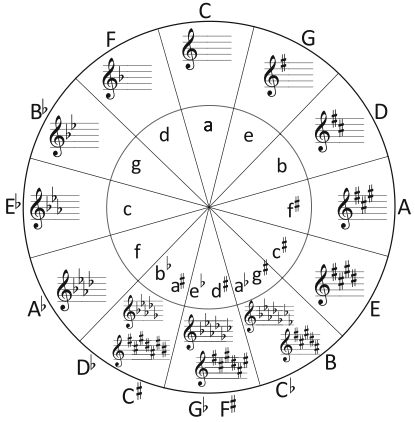
A fretboard hack to remember the entire Circle of Fifths
As before, we'll start with the C Major Scale, since it has no sharps or flats.
Here is the C note on the fretboard:
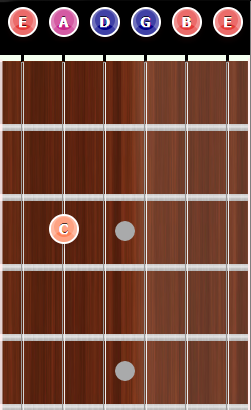
Now we figure out the fifth of a C scale or C Major chord (which are the same note).
The fifth of C is G. On the fretboard, we can do a simple 5th interval, which is up one string, and 2 frets higher.
Here is an example of a 5th interval. Root note, then the 5th, next string higher and 2 frets up.

Now we can see that the G is the 5th interval in the C scale, and the 5th in a C Major Chord.
Of course, you could continue up the neck this way until you run out of strings.
Fortunately, there is a simple "hack" for lack of a better term.
Along with the 5th interval, we learned the octave interval. So, we just get that note one octave down from the 5th.
Since we're only concerned with the names of the scale, it doesn't matter that it's one octave down, or 2, or 5.
We need the note to tell us the next stop in the Circle of Fifths.
Here is an example of the 5th interval and it's octave interval, one octave down.
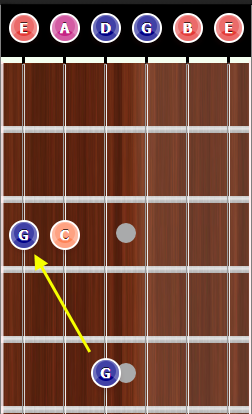
As we know, the octave of G is G. So, we use the G that's one string over from the C, on the low E string.
The interval from G to C, is a 4th interval. you don't necessarily need to know this to use the memory "hack".
Upward and Onward - Next step in the Circle of Fifths
The next step in the Circle of Fifths is the 5th interval of G.
Again, we simply finger a G5 chord to give us the root and fifth.
Doing that, shows us that the 5th of G is D. Since we're using the G on the low E string, we wont be using the Octave/4th interval trick here. We'll leave it where it is.
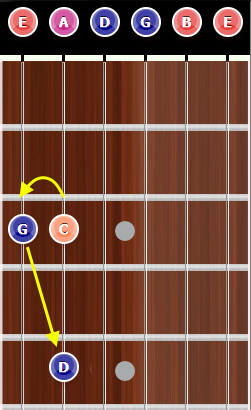
Keep Going....
The next step is a Fifth above D, which is A. Again, we use the octave hack, and use the A next to the D on the low E.
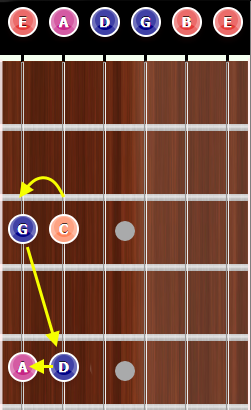
A is the next step after D. At this point, you see the pattern that is beginning to take shape.
For notes on the A string, we use the Octave/inverted 4th hack.
For notes on the Low E, we use standard 5th intervals.
On a Roll now - The Full Pattern Revealed.
As you might alreaddy have guessed, the next step in the Circle of Fifths is a Fifth interval above A, which is E
Here is a look at the pattern through the next several steps on the Circle of Fifths:

"But Wait!!! There's More.
Knowing the next steps on the Circle of Fifths is good to know, but what notes are sharp?
Again, there is a simple trick/hack to help you find out which notes are sharped in a scale.
Let's go back to C Major (first step in the Circle of Fifths) because it has no sharps or flats.
We will take one step backwards in the Circle of Fifths to find it's predecessor.
What chord has C as it's 5th? Simply make a 5th chord with C in the 5th position.
As you can see, F 5th chord has C as it's 5th. So, let's add it to our pattern.
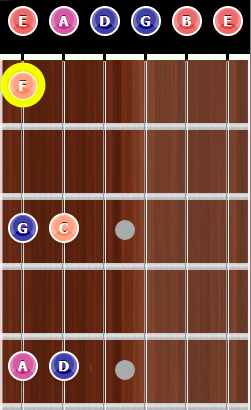
Don't worry, there is a method to my madness.
As stated many times, the first scale is the C Major Scale because it has no sharps or flats.
The next Key is the G Major Key, which has 1 sharped note.
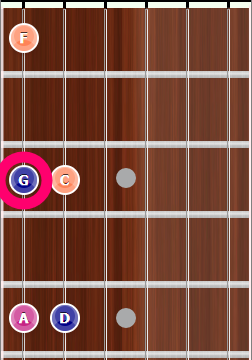
To find the notes that are sharpened, go back 2 steps, and all the previous notes in the Circle of Fifths are sharpened.
In this case, we go back 2 steps, and that leaves us at F.
So, in the G Major Scale, which has one sharp, the F is sharped, giving us F#. G Major Scale has one sharp: F#.
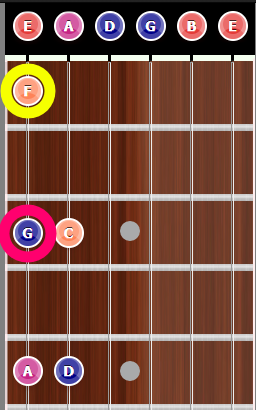
Keep it going!!!!
The next step in the Circle of Fifths is D Major Scale. D Major has 2 sharps.
To find what they are, count back 2 steps and that note and everything prior in the chart are sharped.
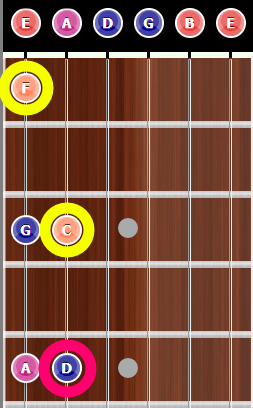
This pattern works all the way up the neck, until you hit 7 Sharps.
So, lets try it on the scale with 7 sharps.
First, we have to find the scale with 7 sharps. So, we traverse the pattern on the neck. C to G, to D, to A, to E, to B, to F#/Gb, to C#/Db
So, the 8 step on the Circle of Fifths is C# Major Scale.
We traverse back 2 steps, and that location, and everything before it is sharped.
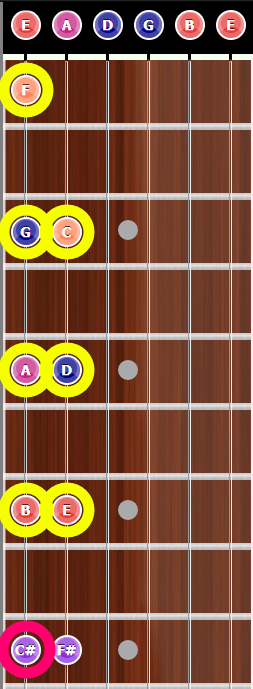
So, the sharps of the C# Major Scale are : F#, C#, G#, D#, A#, E#/F, B#/C
Wrap Up
There are 2 patterns on the fretboard that you can visualize to find out every step on the Circle of Fifths.
You can use that pattern to find out which notes are sharped in each scale.
In this lesson, I only covered sharps, but you can easily traverse the other way, knowing that a 5th is an inverted 4th.
To traverse the other way, counterclockwise, just go from C again, and traverse 4ths from C.
The Key of F has one flat: Bb. Bb is a 4th of F. Happy hunting!!!!